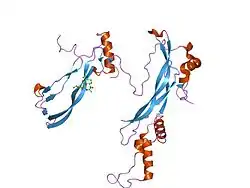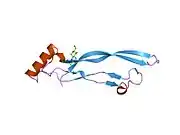پروتئین ۷ ریختزایی استخوان
پروتئین ۷ ریختزایی استخوان (انگلیسی: Bone morphogenetic protein 7) که با نام پروتئین ۱ استخوانساز (OP-1) هم شناخته میشود، یک پروتئین است که در انسان توسط ژن «BMP7» کُدگذاری میشود.[4]
این پروتئین عضوی از خانوادهٔ فاکتور رشد تغییردهنده بتا است. پروتئینهای ریختزایی استخوان قادرند رشد و تکامل غضروف و استخوان را تحریک کنند و پروتئین ۷ ریختزایی نیز نقش مهمی در انتقال سلولهای مزانشیمی به استخوان و غضروف ایفا میکند و توسط کوندرین و ناگین مهار میشود. ژن «BMP7» که در همایستایی نیز نقش دارد در مغز، کلیه و مثانه بیان میشود.[5]
پروتئین ۷ ریختزایی استخوان سبب القایِ فسفریلاسیون SMAD1 و SMAD5 میگردد که به نوبهٔ خود، موجب تحریک رونویسی ژنهای استخوانساز دیگر میگردد.[6]
اهمیت بالینی
پروتئین ۷ ریختزایی استخوان در تکامل کلیهٔ پستانداران نقش دارد[7] و میتوان از آن در درمان «بیماری مزمن کلیوی» بهره برد.[8][9][7] از این پروتئین در ایجاد جوشخوردگی مهرههای کمری[10] و همچنین درمان شکستگیهای جوشنخورده درشتنی که انجامِ پیوند استخوان در آنها موفقیتآمیز نبوده، استفاده میشود.[11] تجویز این پروتئین ممکن است درمان بالقوهٔ ناباروری باشد که پاسخ کافی به مصرف هورمون محرکه فولیکولی ندادهاست.[12]
در آینده ممکن است بتوان از پروتئین ۷ ریختزایی استخوان جهت درمان چاقی در انسان استفاده کرد.[13][14] این پروتئین نه تنها سبب تولید چربی قهوهای (چربی خوب) میشود،[14][15] بلکه موجب تبدیل چربیهای روشن یا طلایی، به چربی قهوهای نیز میگردد.[16]
منابع
- GRCm38: Ensembl release 89: ENSMUSG00000008999 - Ensembl, May 2017
- "Human PubMed Reference:". National Center for Biotechnology Information, U.S. National Library of Medicine.
- "Mouse PubMed Reference:". National Center for Biotechnology Information, U.S. National Library of Medicine.
- Hahn GV, Cohen RB, Wozney JM, Levitz CL, Shore EM, Zasloff MA, Kaplan FS (November 1992). "A bone morphogenetic protein subfamily: chromosomal localization of human genes for BMP5, BMP6, and BMP7". Genomics. 14 (3): 759–62. doi:10.1016/S0888-7543(05)80181-8. PMID 1427904.
- Chen D, Zhao M, Mundy GR (December 2004). "Bone morphogenetic proteins". Growth Factors. 22 (4): 233–41. doi:10.1080/08977190412331279890. PMID 15621726. S2CID 22932278.
- Itoh F, Asao H, Sugamura K, Heldin CH, ten Dijke P, Itoh S (August 2001). "Promoting bone morphogenetic protein signaling through negative regulation of inhibitory Smads". The EMBO Journal. 20 (15): 4132–42. doi:10.1093/emboj/20.15.4132. PMC 149146. PMID 11483516.
- Zeisberg M, Bottiglio C, Kumar N, Maeshima Y, Strutz F, Müller GA, Kalluri R (December 2003). "Bone morphogenic protein-7 inhibits progression of chronic renal fibrosis associated with two genetic mouse models". American Journal of Physiology. Renal Physiology. 285 (6): F1060–7. doi:10.1152/ajprenal.00191.2002. PMID 12915382.
- Gould SE, Day M, Jones SS, Dorai H (January 2002). "BMP-7 regulates chemokine, cytokine, and hemodynamic gene expression in proximal tubule cells". Kidney International. 61 (1): 51–60. doi:10.1046/j.1523-1755.2002.00103.x. PMID 11786084.
- González EA, Lund RJ, Martin KJ, McCartney JE, Tondravi MM, Sampath TK, Hruska KA (April 2002). "Treatment of a murine model of high-turnover renal osteodystrophy by exogenous BMP-7". Kidney International. 61 (4): 1322–31. doi:10.1046/j.1523-1755.2002.00258.x. PMID 11918739.
- Vaccaro AR, Whang PG, Patel T, Phillips FM, Anderson DG, Albert TJ, Hilibrand AS, Brower RS, Kurd MF, Appannagari A, Patel M, Fischgrund JS (2008). "The safety and efficacy of OP-1 (rhBMP-7) as a replacement for iliac crest autograft for posterolateral lumbar arthrodesis: minimum 4-year follow-up of a pilot study". The Spine Journal. 8 (3): 457–65. doi:10.1016/j.spinee.2007.03.012. PMID 17588821.
- Zimmermann G, Müller U, Löffler C, Wentzensen A, Moghaddam A (November 2007). "[Therapeutic outcome in tibial pseudarthrosis: bone morphogenetic protein 7 (BMP-7) versus autologous bone grafting for tibial fractures]". Der Unfallchirurg (به آلمانی). 110 (11): 931–8. doi:10.1007/s00113-007-1347-y. PMID 17989951.
- Shi J, Yoshino O, Osuga Y, Nishii O, Yano T, Taketani Y (March 2010). "Bone morphogenetic protein 7 (BMP-7) increases the expression of follicle-stimulating hormone (FSH) receptor in human granulosa cells". Fertility and Sterility. 93 (4): 1273–9. doi:10.1016/j.fertnstert.2008.11.014. PMID 19108831.
- Jha A (2008-08-21). "Obesity: Scientists identify protein that promotes fat-burning". Science. guardian.co.uk. Retrieved 2008-09-03.
- Tseng YH, Kokkotou E, Schulz TJ, Huang TL, Winnay JN, Taniguchi CM, et al. (August 2008). "New role of bone morphogenetic protein 7 in brown adipogenesis and energy expenditure". Nature. 454 (7207): 1000–4. doi:10.1038/nature07221. PMC 2745972. PMID 18719589.
- Townsend KL, Suzuki R, Huang TL, Jing E, Schulz TJ, Lee K, Taniguchi CM, Espinoza DO, McDougall LE, Zhang H, He TC, Kokkotou E, Tseng YH (May 2012). "Bone morphogenetic protein 7 (BMP7) reverses obesity and regulates appetite through a central mTOR pathway". FASEB Journal. 26 (5): 2187–96. doi:10.1096/fj.11-199067. PMC 3336788. PMID 22331196.
- Okla M, Ha JH, Temel RE, Chung S (February 2015). "BMP7 drives human adipogenic stem cells into metabolically active beige adipocytes". Lipids. 50 (2): 111–20. doi:10.1007/s11745-014-3981-9. PMC 4306630. PMID 25534037.
- مشارکتکنندگان ویکیپدیا. «Bone morphogenetic protein 7». در دانشنامهٔ ویکیپدیای انگلیسی، بازبینیشده در ۱۵ مارس ۲۰۲۱.
برای مطالعهٔ بیشتر
- Xiao HQ, Shi W, Zhang Y, Liang YZ (April 2009). "[Effect of bone morphogenic protein 7 on nephrin expression and distribution in diabetic rat kidneys]". Nan Fang Yi Ke da Xue Xue Bao = Journal of Southern Medical University. 29 (4): 671–5. PMID 19403392.
- Murray LA, Hackett TL, Warner SM, Shaheen F, Argentieri RL, Dudas P, Farrell FX, Knight DA (2008). Eickelberg O, ed. "BMP-7 does not protect against bleomycin-induced lung or skin fibrosis". PLOS ONE. 3 (12): e4039. doi:10.1371/journal.pone.0004039. PMC 2603595. PMID 19112509.
- Freedman BI, Bowden DW, Ziegler JT, Langefeld CD, Lehtinen AB, Rudock ME, Lenchik L, Hruska KA, Register TC, Carr JJ (October 2009). "Bone morphogenetic protein 7 (BMP7) gene polymorphisms are associated with inverse relationships between vascular calcification and BMD: the Diabetes Heart Study". Journal of Bone and Mineral Research. 24 (10): 1719–27. doi:10.1359/jbmr.090501. PMC 2743282. PMID 19453255.
- Garriock HA, Kraft JB, Shyn SI, Peters EJ, Yokoyama JS, Jenkins GD, Reinalda MS, Slager SL, McGrath PJ, Hamilton SP (January 2010). "A genomewide association study of citalopram response in major depressive disorder". Biological Psychiatry. 67 (2): 133–8. doi:10.1016/j.biopsych.2009.08.029. PMC 2794921. PMID 19846067.
- Reddi AH (July 2000). "Bone morphogenetic proteins and skeletal development: the kidney-bone connection". Pediatric Nephrology. 14 (7): 598–601. doi:10.1007/s004670000364. PMID 10912525. S2CID 20757453.
- Gautschi OP, Cadosch D, Zellweger R, Joesbury KA, Filgueira L (2009). "Apoptosis induction and reduced proliferation in human osteoblasts by rhBMP-2, -4 and -7". Journal of Musculoskeletal & Neuronal Interactions. 9 (1): 53–60. PMID 19240369.
- Alarmo EL, Pärssinen J, Ketolainen JM, Savinainen K, Karhu R, Kallioniemi A (March 2009). "BMP7 influences proliferation, migration, and invasion of breast cancer cells". Cancer Letters. 275 (1): 35–43. doi:10.1016/j.canlet.2008.09.028. PMID 18980801.
- Elshaier AM, Hakimiyan AA, Rappoport L, Rueger DC, Chubinskaya S (January 2009). "Effect of interleukin-1beta on osteogenic protein 1-induced signaling in adult human articular chondrocytes". Arthritis and Rheumatism. 60 (1): 143–54. doi:10.1002/art.24151. PMC 2626196. PMID 19116903.
- Yerges LM, Klei L, Cauley JA, Roeder K, Kammerer CM, Moffett SP, Ensrud KE, Nestlerode CS, Marshall LM, Hoffman AR, Lewis C, Lang TF, Barrett-Connor E, Ferrell RE, Orwoll ES, Zmuda JM (December 2009). "High-density association study of 383 candidate genes for volumetric BMD at the femoral neck and lumbar spine among older men". Journal of Bone and Mineral Research. 24 (12): 2039–49. doi:10.1359/jbmr.090524. PMC 2791518. PMID 19453261.
- Dudas PL, Argentieri RL, Farrell FX (May 2009). "BMP-7 fails to attenuate TGF-beta1-induced epithelial-to-mesenchymal transition in human proximal tubule epithelial cells". Nephrology, Dialysis, Transplantation. 24 (5): 1406–16. doi:10.1093/ndt/gfn662. PMID 19056781.
- Honsawek S, Chayanupatkul M, Tanavalee A, Sakdinakiattikoon M, Deepaisarnsakul B, Yuktanandana P, Ngarmukos S (August 2009). "Relationship of plasma and synovial fluid BMP-7 with disease severity in knee osteoarthritis patients: a pilot study". International Orthopaedics. 33 (4): 1171–5. doi:10.1007/s00264-009-0751-z. PMC 2898966. PMID 19301001.
- Sengle G, Ono RN, Lyons KM, Bächinger HP, Sakai LY (September 2008). "A new model for growth factor activation: type II receptors compete with the prodomain for BMP-7". Journal of Molecular Biology. 381 (4): 1025–39. doi:10.1016/j.jmb.2008.06.074. PMC 2705212. PMID 18621057.
- Mitu G, Hirschberg R (May 2008). "Bone morphogenetic protein-7 (BMP7) in chronic kidney disease". Frontiers in Bioscience. 13 (13): 4726–39. doi:10.2741/3035. PMID 18508541.
- Brown A, Stock G, Patel AA, Okafor C, Vaccaro A (2006). "Osteogenic protein-1 : a review of its utility in spinal applications". BioDrugs. 20 (4): 243–51. doi:10.2165/00063030-200620040-00005. PMID 16831023. S2CID 23434940.
- Fajardo M, Liu CJ, Egol K (December 2009). "Levels of expression for BMP-7 and several BMP antagonists may play an integral role in a fracture nonunion: a pilot study". Clinical Orthopaedics and Related Research. 467 (12): 3071–8. doi:10.1007/s11999-009-0981-9. PMC 2772945. PMID 19597895.
- Giannoudis PV, Kanakaris NK, Dimitriou R, Gill I, Kolimarala V, Montgomery RJ (December 2009). "The synergistic effect of autograft and BMP-7 in the treatment of atrophic nonunions". Clinical Orthopaedics and Related Research. 467 (12): 3239–48. doi:10.1007/s11999-009-0846-2. PMC 2772926. PMID 19396502.
- Kalluri R, Neilson EG (December 2003). "Epithelial-mesenchymal transition and its implications for fibrosis". The Journal of Clinical Investigation. 112 (12): 1776–84. doi:10.1172/JCI20530. PMC 297008. PMID 14679171.
- Zhu L, Chuanchang D, Wei L, Yilin C, Jiasheng D (March 2010). "Enhanced healing of goat femur-defect using BMP7 gene-modified BMSCs and load-bearing tissue-engineered bone". Journal of Orthopaedic Research. 28 (3): 412–8. doi:10.1002/jor.20973. PMID 19725097. S2CID 12548359.
- Vieira AR, McHenry TG, Daack-Hirsch S, Murray JC, Marazita ML (September 2008). "Candidate gene/loci studies in cleft lip/palate and dental anomalies finds novel susceptibility genes for clefts". Genetics in Medicine. 10 (9): 668–74. doi:10.1097/GIM.0b013e3181833793. PMC 2734954. PMID 18978678.
- Kron K, Pethe V, Briollais L, Sadikovic B, Ozcelik H, Sunderji A, Venkateswaran V, Pinthus J, Fleshner N, van der Kwast T, Bapat B (2009). "Discovery of novel hypermethylated genes in prostate cancer using genomic CpG island microarrays". PLOS ONE. 4 (3): e4830. doi:10.1371/journal.pone.0004830. PMC 2653233. PMID 19283074.
پیوند به بیرون
- bone morphogenetic protein 7 در سرعنوانهای موضوعی پزشکی (MeSH) در کتابخانهٔ ملی پزشکی ایالات متحدهٔ آمریکا
- مکان ژنوم BMP7 انسانی و صفحهٔ جزئیات ژنی BMP7 در سامانه جستجوی بانک ژنی دانشگاه کالیفرنیا، سانتا کروز.





